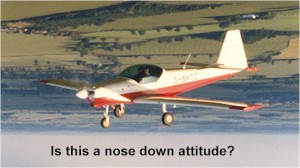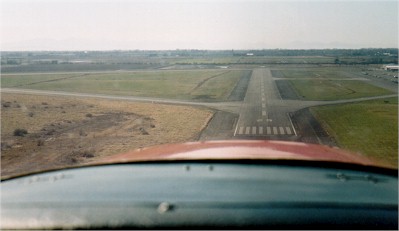
In our last flight we stalled the aeroplane in what we call the clean configuration; that is with the Flaps up, and the power reduced completely, (“power off”). In this lesson we’ll stall in several other configurations in order to simulate situations that we might find ourselves in during our flying career.
The objective of doing these exercises is so that we learn to recognise the proximity of the stall, and how to recover from it, and this is very very important to our safety.
Flaps are devices that both increase the lift of the wing and its drag. Increasing the lift is useful in reducing the stall speed and hence the landing speed, this saves tyre wear and reduces the length of the runway we need to use.
Drag is useful in that we can descend much more steeply. If we want to descend vertically we use a parachute, right? A parachute is pure drag, whereas we don’t need to descend vertically, you might see that a steep approach can be very useful when there are trees at the end of the runway.

The Cessna 152 is fitted with highly effective Fowler Flaps.
Remember I mentioned that the Rudder becomes the primary roll control when you are in Slow Flight, well now you’re going to learn why!
So first of all we’ll do our HASELL (or HALT) checks, and then we’ll ensure we are within the Flap Limit Speed depicted by a white arc on the Airspeed Indicator. Let’s apply 20 degrees of flap and reduce the power to 1500 rpm; remember to apply Carburetor Heat to prevent icing.
The aeroplane will slow down quite quickly due to the additional drag produced by the flaps and so we have to raise the nose at a noticeable rate to maintain our altitude.
The stall warner will go off, and then the nose drops much more markedly than before, and oops the wing has dropped as well!
Like before we apply Full Power, Lower The Nose, to unstall the wings, and at the same time we Apply Opposite Rudder, to stop the wing from dropping further. With the airspeed now increasing we can Roll the wings level using the Ailerons by rotating the control column.

The wing dropped because there was yaw present at the point of stall. Think of yaw as a rotation around the Normal Axis. If the aeroplane is yawing to the right, the left wing will have more lift than the right, and if this situation occurs at the point of the stall the right wing will stall before the left and so it will drop.
This is why we use the rudder as a primary Roll control at low speeds; close to the stall the down going aileron can actually cause its wing to stall!
Using the rudder to control the yaw is very important at low speeds.

You are now equipped to recognise and prevent the stall when you are busy doing the landing approach later on in your training.
If you do not recover from the wing drop stall, you will enter the Incipient and then maybe the full Spin. In the next lesson we will look at spinning.